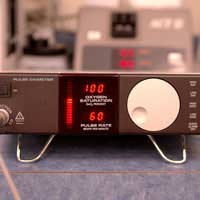What is a Pulse Oximeter?

A pulse oximeter is a piece of medical equipment that has been specially designed to monitor the oxygen levels within the blood. It can also register the patient's heart rate and is a very useful and frequently used device utilised in all parts of the health service.
How Does it Work?
It is a non-invasive piece of equipment, using a probe that can be attached to a finger, toe or ear lobe. It is not painful or uncomfortable and the probes are designed to fit the area it is applied to snugly.Using wavelengths and infrared technology, the probe recognises the differences between oxygenated blood and deoxygenated blood and calculates the ratio between the two. From this a percentage rate is produced and displayed on a screen as a saturation and is given as a percentage.
A healthy person will normally have a reading of at least 95% saturation, though many will manage to live quite happily on a reduced amount such as 90%.
Why do I Need my Oxygen Levels Monitored?
Almost all people who feel unwell enough to require hospitalisation will have their oxygen levels checked via pulse oximetry, as often this can show the first signs of any underlying problems.Any conditions of the lungs, heart or blood flow and blood volume will be represented by the reading given by the machine.If at any time, the saturation level drops below the level that is normal for that person, or below 90%, investigations and corrective treatments will be needed to determine the cause and treat as necessary.
Pulse oximetry is used throughout surgical procedures, especially those that involve the use of general anaesthetics and help the doctors to assess the overall health of their patient. It will also be monitored post-operatively and becomes a routine part of the observations such as blood pressure and heart rate that will be frequently monitored by the nurses in the immediate recovery period following surgery.
Pulse oximetry is becoming a very widely used tool in the initial stages of diagnosing congenital heart disease in the newborn, especially those who show no other symptoms of the illness. A reading can indicate that further tests are necessary to help achieve a speedy diagnosis and a formation of an appropriate treatment plan.
Limitations of Use
Although pulse oximetry is a very widely used tool for monitoring blood oxygenation levels, it cannot offer a profile of blood gas analysis and cannot act as a substitute for taking a blood sample and examining it’s content. It can act purely as an indicator that something somewhere is interfering with the oxygenation of blood levels and is simply an indicator that further investigation is required.A full medical history should be taken as certain conditions can cause false readings to occur, as can faulty equipment or excessive patient movement whilst the readings are being taken.
The use of pulse oximetry is a very useful tool used by almost all health professionals and patients at some point. Without it, complications of many illnesses would go undetected for much longer causing prolonged strain and for the patient along with the possibility of the condition worsening.
- Natiuretic Peptides and Heart Failure
- What Are Cardiac Biomarkers?
- CT Scan Screening for Heart Disease
- Carotid Duplex Scanning
- What is an Electrocardiogram (ECG)?
- Having a Chest X-ray
- CT Scans and MRI Scans
- All About Echocardiography
- What is an Exercise Test?
- What is a Transoesophageal Echocardiogram?


Re: Laser Surgery for Coronary Artery Disease
I was diagnosed with Idiopathic Pulmonary Fibrosis (IPF) four years ago. For over two years, I relied on…
Re: Coronary Angioplasty Surgery
My husband had a stent put in at the beginning of January. It was done at a government hospital and the doctors appointment is…
Re: Hole in the Heart: What Happens Next?
I was just in hospital with left side pain and numbness was diagnosed with hole in heart I’m home now and I’m having…
Re: Hole in the Heart: What Happens Next?
Ok I'm 61 yes old.ive been in 3 motorcycle wrecks,I have sticky platelets I've been hospitalized 3:times with blood…
Re: Why Does My Heart Beat Faster After Sweet Food?
The coffee doesn't make a heart beat faster. Caffeine makes the hart beat harder/stronger. The sugar…
Re: Hole in the Heart: What Happens Next?
Hi Doctor, My friend is having 35 years and he is having a hole in the heart, he consulted many doctors in USA and…
Re: What is Heart Block?
Hello. I have born first degree heart block. 10 years ago was temporarily changing to 2 degrees, but stay first degree. Am I at high risk…
Re: Hole in the Heart: What Happens Next?
In Sept '16 I was diagnosed with hypertension (high blood pressure) and in May '17 I had a stroke - the only symptoms…
Re: Hole in the Heart: What Happens Next?
Hi Iam 53 years old and living very healthy life. I have blood pressure but it is in normal condition with proper…
Re: What is Heart Block?
Hi there I had a pacemaker fitted last year for Mobitz II heart block. My pacemaker is set to fire if my rate drops below 60 b/pm. Am I…